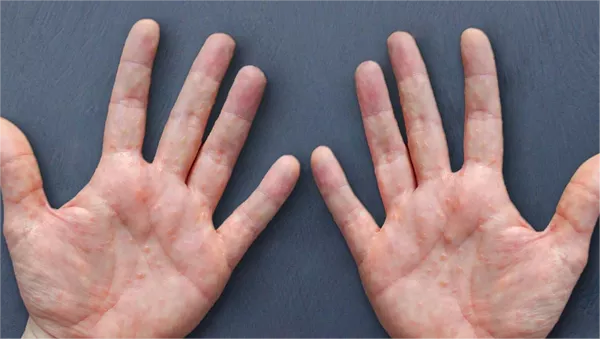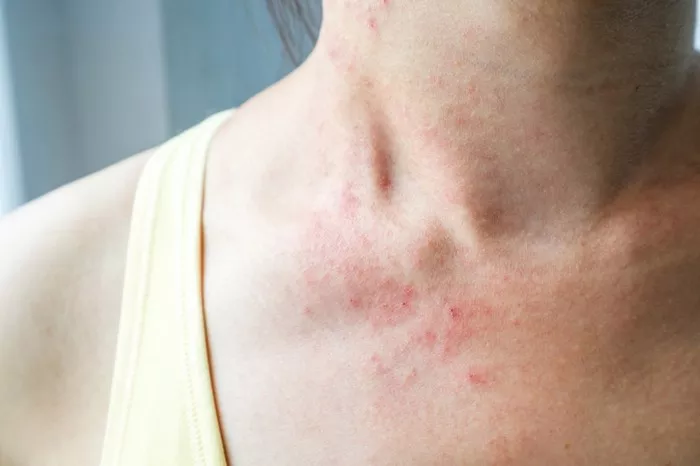Dyshidrotic eczema, also known as pompholyx or vesicular eczema, is a chronic skin condition that affects the fingers, palms, and soles of the feet. Characterized by the formation of small, intensely itchy blisters, dyshidrotic eczema can be both painful and debilitating. While the exact cause remains unclear, various factors, including allergies, stress, and sweat, are believed to contribute to the condition. This article explores effective strategies to treat and manage dyshidrotic eczema on the fingers, aiming to alleviate symptoms and improve quality of life.
Understanding Dyshidrotic Eczema
Dyshidrotic eczema typically presents as sudden outbreaks of small, fluid-filled blisters on the sides of the fingers, palms, and soles. These blisters are often accompanied by itching, burning, and swelling, which can make daily activities challenging. The condition is more common in adults aged 20-40 and tends to recur periodically.
1. Causes and Triggers
While the exact cause of dyshidrotic eczema is unknown, several factors are thought to contribute to its development:
- Allergens: Nickel, cobalt, and other metals found in everyday objects can trigger outbreaks.
- Stress: Emotional and physical stress can exacerbate symptoms.
- Sweating: Excessive sweating, particularly on the hands and feet, is a common trigger.
- Weather: Hot and humid or cold and dry conditions can worsen symptoms.
- Irritants: Exposure to soaps, detergents, and other chemicals can irritate the skin.
2. Symptoms
The primary symptoms of dyshidrotic eczema include:
- Small, itchy blisters on the sides of the fingers, palms, or soles.
- Red, inflamed skin around the blisters.
- Cracked, peeling skin as the blisters heal.
- Pain and discomfort, particularly when blisters are present.
3. Diagnosis
A dermatologist typically diagnoses dyshidrotic eczema through a physical examination and patient history. In some cases, skin patch testing may be performed to identify potential allergens. Additional tests, such as skin biopsies, may be conducted to rule out other conditions.
SEE ALSO: How to Treat Varicose Eczema Naturally
Treatment Options
Topical Treatments
1. Corticosteroids
- Topical Corticosteroids: These are the first line of treatment for dyshidrotic eczema. They reduce inflammation and alleviate itching. Potent corticosteroids, such as clobetasol propionate, are often prescribed for short-term use during flare-ups.
- Application: Apply a thin layer to the affected areas once or twice daily as directed by a healthcare provider. It’s essential to follow the prescribed regimen to avoid potential side effects, such as skin thinning.
2. Calcineurin Inhibitors
- Tacrolimus and Pimecrolimus: These non-steroidal medications are used for moderate to severe cases. They work by suppressing the immune response that causes inflammation.
- Benefits: Suitable for long-term use and areas with thinner skin, such as fingers.
Systemic Treatments
1. Oral Corticosteroids
- Short-term Use: For severe flare-ups, oral corticosteroids like prednisone may be prescribed. These reduce inflammation systemically and provide rapid relief.
- Caution: Due to potential side effects, long-term use is discouraged.
2. Immunosuppressants
- Methotrexate, Cyclosporine, and Azathioprine: These medications are considered for chronic and severe cases unresponsive to other treatments. They reduce immune system activity and inflammation.
- Monitoring: Regular blood tests and medical supervision are necessary to manage side effects.
Phototherapy
Narrowband UVB Therapy: Exposing the skin to ultraviolet light under medical supervision can help reduce inflammation and clear up blisters.
PUVA Therapy: Combines a drug called psoralen with UVA light. Effective but requires careful monitoring due to potential side effects, such as increased risk of skin cancer.
Lifestyle and Home Remedies
1. Moisturizers
- Regular Application: Keeping the skin moisturized helps prevent dryness and cracking. Use fragrance-free, hypoallergenic moisturizers multiple times daily.
- Ointments and Creams: Prefer thicker ointments like petroleum jelly or creams with ceramides.
2. Cold Compresses
- Relief from Itching: Applying a cold compress to affected areas can provide temporary relief from itching and reduce inflammation.
3. Avoiding Triggers
- Identify and Avoid Allergens: Be mindful of metals like nickel and cobalt in jewelry, keys, and other objects.
- Reduce Stress: Practice stress-reducing techniques such as yoga, meditation, and deep-breathing exercises.
- Protective Measures: Wear gloves when handling detergents, soaps, and other potential irritants. Use cotton gloves inside rubber gloves for additional protection.
Diet and Nutrition
Anti-inflammatory Diet: Incorporate foods rich in antioxidants and omega-3 fatty acids, such as fruits, vegetables, fish, and nuts.
Avoid Potential Allergens: Identify and eliminate food allergens that may trigger eczema.
Complementary and Alternative Therapies
1. Acupuncture
- Symptom Relief: Some studies suggest that acupuncture may help reduce itching and improve overall skin health.
- Consultation: Seek a licensed practitioner experienced in treating eczema.
2. Herbal Remedies
- Aloe Vera and Calendula: These natural remedies may soothe the skin and reduce inflammation.
- Caution: Always consult a healthcare provider before starting any herbal treatment.
Long-term Management and Prevention
1. Skincare Routine
- Gentle Cleansing: Use mild, fragrance-free cleansers. Avoid hot water and harsh scrubbing.
- Regular Moisturizing: Apply a thick moisturizer immediately after bathing to lock in moisture.
2. Environmental Control
- Humidity Control: Use a humidifier during dry months to maintain skin hydration.
- Protective Clothing: Wear gloves and appropriate clothing to protect the skin from irritants and harsh weather.
3. Regular Follow-ups
- Dermatologist Visits: Regular check-ups with a dermatologist help monitor the condition and adjust treatment as necessary.
- Patch Testing: Periodic patch testing can identify new allergens that may develop over time.
Conclusion
Dyshidrotic eczema on the fingers can significantly impact daily life, but with proper treatment and management, symptoms can be controlled effectively. A combination of topical and systemic treatments, lifestyle modifications, and preventive measures is essential for managing this chronic condition. Regular consultations with a dermatologist and staying informed about new treatment options can help individuals lead a more comfortable and productive life despite dyshidrotic eczema.
Additional Resources
For more information on dyshidrotic eczema, consider visiting reputable sources such as:
- National Eczema Association: Provides comprehensive resources on eczema management and treatment.
- American Academy of Dermatology: Offers information on skin conditions, treatment options, and finding a dermatologist.
- Mayo Clinic: A trusted source for medical information and advice on managing chronic conditions like dyshidrotic eczema.
By understanding the nature of dyshidrotic eczema and adopting a holistic approach to treatment and management, individuals can achieve better control over their symptoms and improve their quality of life.
Related Topics:
























